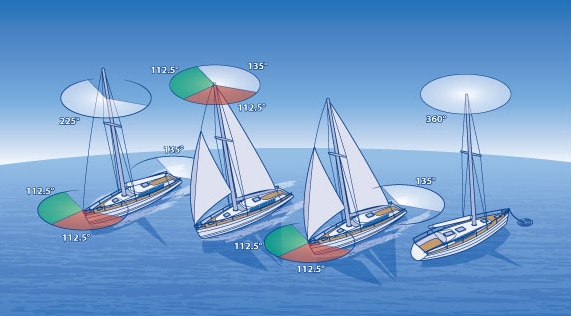
Running Lights
There’s one sure way to avoid being run down when sailing at night: Be seen. Make yourself visible by putting your running lights in good working order, and ensure that they comply with U.S. Coast Guard regulations. If you’re involved in a collision and your navigation lights aren’t compliant, you may be found at fault.
The most common problems involve how and where the lights are mounted. Take a careful look at each fixture; depending on the size of your vessel and its configuration of sail and power, your boat may have as many as six navigation lights: port, starboard, stern, masthead tricolor, steaming, and anchor. Make sure that no light is obstructed in any way. The usual suspects include davit-hung tenders and other stern-mounted gear as well as mast-mounted radar domes. In some cases, I’ve seen the transom itself block a portion of a stern light’s required arc of visibility.
Additionally, be sure that your side lights are mounted on surfaces that are vertical and parallel with the boat’s centerline. Side lights that are mounted on bow rails and are parallel with the rail rather than the centerline can have the effect of overlapping their red and green arcs when viewed from angles other than dead ahead, making it seem to others who are forward of you as if you’re heading directly for them when, in fact, you may not be.
Stern and masthead lights should be vertical and mounted perpendicular to the vessel’s centerline.
Side lights must be installed above the sheer line. Even if this weren’t a regulation, I’d strongly recommend replacing ones embedded in the hull; they’re less visible, particularly when the boat’s heeled, and are exposed to spray and a greater chance of immersion.
Tricolor lights can only be used when under sail. Under power, conventional deck-level lights and a steaming light must be used. At no time can both deck and tricolor lights shine simultaneously. In order to avoid this nav-light faux pas, consider installing a two-position switch (supplied by a nav-light circuit breaker) that activates either the steaming or sailing configuration.
When selecting, inspecting, and replacing navigation lights, be sure that they carry a U.S. Coast Guard approval label. Select fixtures that are appropriate for your vessel’s length, and make sure that the wattage of every bulb is correct.
Imagine disassembling a light housing with a small screwdriver while you’re hanging over a bow rail or sitting in a bosun’s chair; I prefer to use incandescent fixtures that can be serviced without tools. Remember, too, that while L.E.D. lights are virtually exempt from bulb failure, they’re no less prone to wiring and connection issues. Make certain that all nav-light wiring is fully waterproofed using either heat-shrink tubing and/or sealant. Wiring to masthead lights should be run so that its weight isn’t supported by the fixture.
Navigation lights are your ally in the safe handling of your vessel. Make sure that yours can always be seen.
Steve D’Antonio offers services for boat owners and buyers through Steve D’Antonio Marine Consulting.








